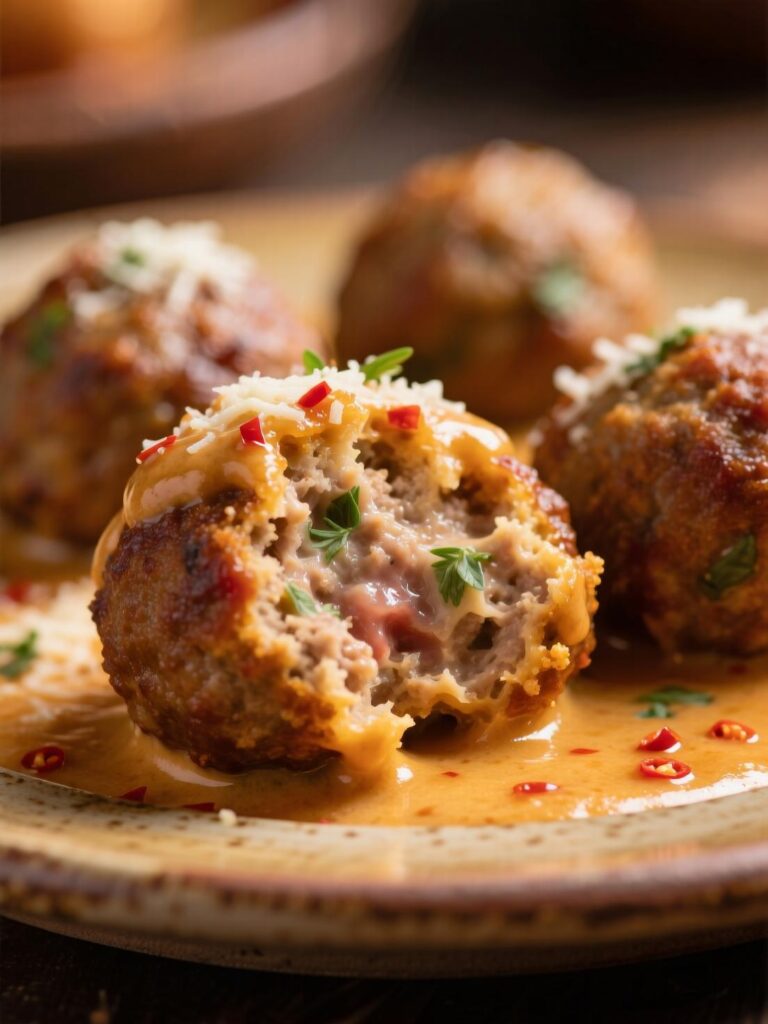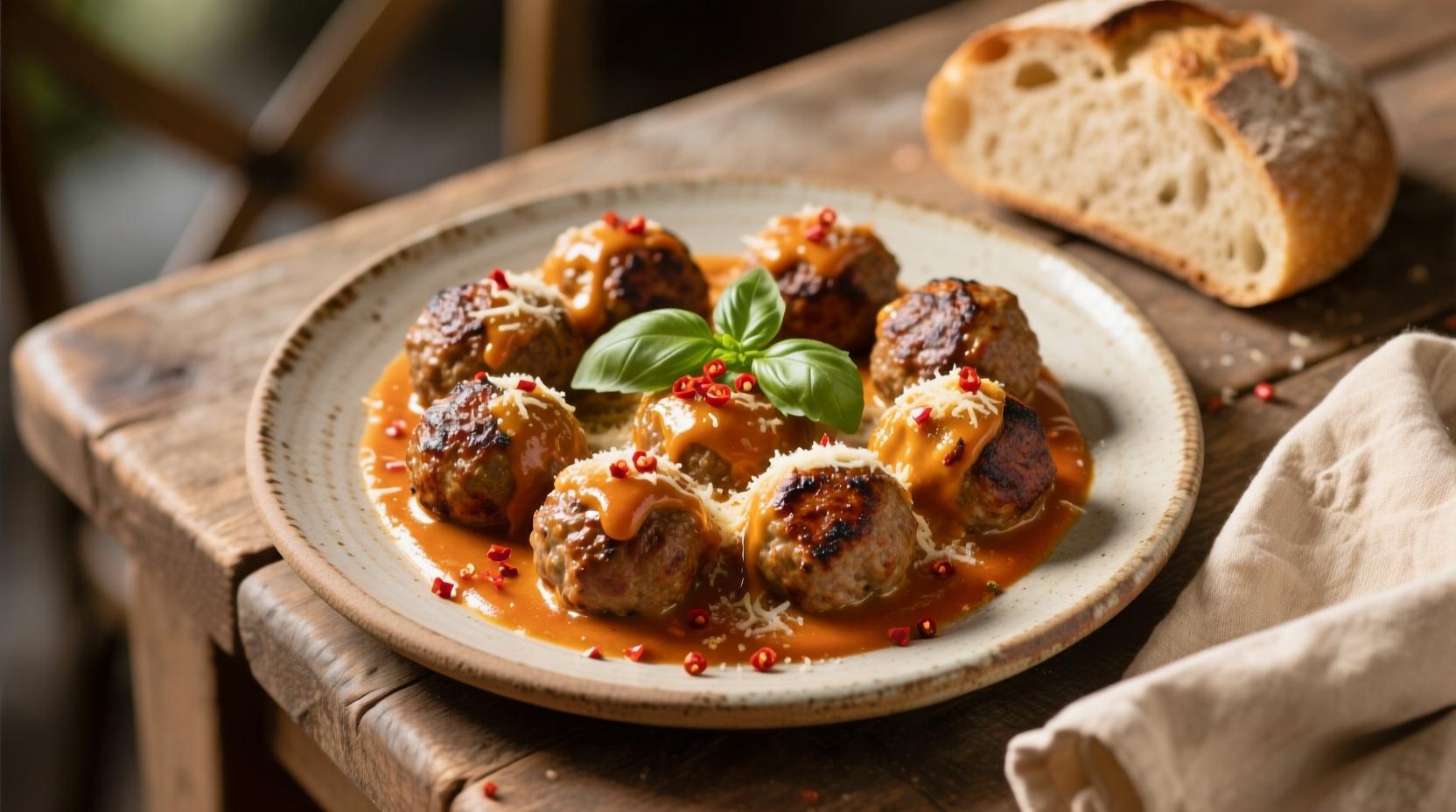Some recipes are just names. Others—well, they’re stories in a skillet. Marry Me Chicken Meatballs is one of those dishes that doesn’t just feed you—it whispers something in your ear. The kind of dish that, once served, feels like a commitment has been made. Chefs love it for its depth of flavor. Home cooks adore it for its easy elegance. And me? I see it as the perfect balance between rustic comfort and fine dining charm.
If you’ve never made it before, you might think it’s just chicken meatballs in a sauce. But that’s like saying champagne is just fizzy wine. There’s more here—layers of flavor, textural contrasts, and an interplay between acidity, creaminess, and savoriness that, if handled right, can absolutely floor your guests.
Understanding the Essence of Marry Me Chicken Meatballs
This dish originates from the internet-famous “Marry Me Chicken,” which became a sensation for its creamy sun-dried tomato sauce and romantic lore. Food bloggers claimed it was so good, someone might propose after tasting it. Chefs took that as a challenge—and here we are, with a meatball version that arguably surpasses the original.
The twist of using chicken meatballs adds a new dimension. Ground chicken, being lean and mild, is a perfect flavor sponge. It picks up the herby, garlicky notes and soaks in the sauce without overpowering it. But it also demands respect—you can’t just toss it in a pan and hope for the best. Without proper handling, chicken meatballs dry out faster than an overcooked soufflé.
The Science Behind Perfect Chicken Meatballs
Here’s where experience counts. Chicken is lean—around 10% fat compared to beef’s 20-30%. Fat equals juiciness, so when we lose it, we must compensate. That’s where binders like breadcrumbs and eggs step in. But the real secret? Moisture boosters. Finely minced onions, a touch of milk, or even ricotta cheese can make chicken meatballs taste rich without loading them with actual fat.
Texture control is key. Over-mixing ground chicken can tighten the proteins, leading to dense meatballs. Gentle folding is the move. Think of it like coaxing rather than forcing the ingredients together. And when shaping them, wet hands prevent sticking and help keep the balls smooth—small details, big impact.

Ingredients That Truly Matter
Professional kitchens don’t just shop—they source. If you want these meatballs to be irresistible, ingredient quality isn’t optional.
- Ground Chicken: Aim for a mix with some thigh meat. Breast-only blends can be too dry.
- Sun-Dried Tomatoes: Packed in oil, not the dry bagged type. The oil is a flavor bomb—don’t waste it.
- Parmesan Cheese: Freshly grated, never the pre-shredded kind. It melts cleaner and has a sharper bite.
- Fresh Herbs: Basil is non-negotiable, but thyme and parsley can play backup.
- Heavy Cream: Full fat. Half-and-half will break your sauce dreams.
Even the chicken stock matters—homemade has a subtlety that store-bought often bulldozes over. If you must use packaged, find low-sodium to keep control over seasoning.
Step-by-Step: The Professional Workflow
In a professional kitchen, timing and efficiency are king. Everything flows like a small orchestra. Here’s how I’d do it.
1. Prepping the Meatballs
Mix ground chicken with panko breadcrumbs, a beaten egg, grated Parmesan, minced onion, chopped parsley, salt, and pepper. Add a splash of milk—just enough to loosen the mixture. Handle gently. Shape into 1.5-inch balls with wet hands.
2. Searing for Flavor
Heat a blend of olive oil and butter in a wide sauté pan. Brown the meatballs on all sides over medium-high heat. Don’t rush—color equals flavor. Remove and set aside.
3. Building the Sauce Base
In the same pan, sauté minced garlic until fragrant. Toss in chopped sun-dried tomatoes with a little of their oil. Deglaze with chicken stock, scraping up the fond—the browned bits are liquid gold.
4. Creamy Magic
Stir in heavy cream, bring to a gentle simmer. Add grated Parmesan and let it melt into the sauce. Season with salt, pepper, and a pinch of crushed red pepper flakes for warmth.
5. The Union
Return the meatballs to the sauce. Simmer gently for 8-10 minutes until cooked through. Fresh basil goes in at the very end for that bright, green pop.
6. Serving It Right
Serve over pasta, mashed potatoes, or with crusty bread. In a restaurant, I’d finish with micro basil and a drizzle of the sun-dried tomato oil for plating finesse.

Common Mistakes and How to Dodge Them
A rookie move? Overcrowding the pan. Meatballs steam instead of sear, and you lose the Maillard reaction. Another trap—overcooking. Chicken should hit 165°F internally, but pulling it at 162°F and resting it lets carryover cooking finish the job without drying it out.
Some people try to cut fat from the recipe. Bad idea. This sauce needs richness to balance the acidity of the tomatoes. If you really must lighten it, swap half the cream for evaporated milk—not milk, which will split.
Why This Dish Works in Both Home and Pro Kitchens
The genius of this recipe is scalability. You can cook a small batch for date night or scale up to feed fifty without flavor loss. In catering, I’ve used this for plated dinners and buffet lines—it holds well under gentle heat. And because the sauce clings to the meatballs, it’s less messy than pasta dishes for events.
From a business standpoint, chicken meatballs cost less than beef or lamb. Even with high-quality sun-dried tomatoes and cream, your food cost stays in a healthy range. That’s why many bistros keep a variation of this on their menu—it’s high-margin comfort food that looks fancier than it is.
Pairing Like a Pro
If you’re thinking wine, you’re not wrong. The creamy tomato base loves a medium-bodied white like Chardonnay (oak-aged for complexity) or a light red like Pinot Noir. Beer drinkers? Go Belgian-style blonde ale—it’s got the right yeastiness to cut through the sauce.
For sides, think texture contrast. A crisp green salad with a sharp vinaigrette refreshes the palate. Roasted vegetables bring earthy depth. And bread—always bread. Something with a crust so hard it fights back a little.
A Little Data for the Curious
In 2023, Google Trends showed “Marry Me Chicken” searches peaking around Valentine’s Day and Christmas. That tells you something—people are drawn to this dish for romantic or special occasions. Translating that to a menu means you can market it as a seasonal special and ride the wave of interest.
Variations That Keep the Soul but Change the Mood
- Mediterranean Twist: Add kalamata olives and swap basil for oregano.
- Spicy Version: Stir Calabrian chili paste into the sauce.
- Lighter Touch: Use turkey meatballs and a yogurt-based sauce (though it won’t be as silky).
Chefs often adapt recipes to fit regional tastes or available produce. This one’s flexible enough to play along.
Final Notes from the Kitchen
Marry Me Chicken Meatballs isn’t just about making something “good.” It’s about crafting an experience. The aroma when the garlic hits the pan. The hiss when you deglaze with stock. The way cream swirls into orange-gold silk around those meatballs.
Serve it right, and you’ll see it happen—the fork pause, the slow chew, the glance up. That moment when the dish has done its work. And whether or not anyone proposes after, you’ll know you’ve cooked something worth remembering.
FAQs
What is Marry Me Chicken Meatballs?
It’s a creamy, sun-dried tomato chicken meatball dish inspired by the famous Marry Me Chicken recipe.
Can I use ground turkey instead of chicken?
Yes, but it may be slightly leaner, so add extra moisture like ricotta or milk.
How do I keep chicken meatballs juicy?
Avoid over-mixing, use binders like breadcrumbs and egg, and add moisture boosters.
Can I make this dish ahead of time?
Yes, store the meatballs and sauce separately, then combine and reheat gently before serving.
What can I serve with Marry Me Chicken Meatballs?
It pairs well with pasta, mashed potatoes, or crusty bread for soaking up the sauce.
Can I freeze Marry Me Chicken Meatballs?
Yes, freeze them in sauce for up to 2 months, then thaw and reheat slowly.
What’s the best wine pairing for this dish?
A lightly oaked Chardonnay or a fruity Pinot Noir complements the creamy tomato sauce.
How long should I cook chicken meatballs?
Simmer in sauce until they reach an internal temperature of 165°F, about 8–10 minutes after browning.
Do I need to use sun-dried tomatoes in oil?
Yes, they have richer flavor and the oil adds extra depth to the sauce.
Can I make it dairy-free?
Yes, use coconut cream instead of heavy cream and nutritional yeast instead of Parmesan.

Mariana is a passionate home cook who creates delicious, easy-to-follow recipes for busy people. From energizing breakfasts to satisfying dinners and indulgent desserts, her dishes are designed to fuel both your body and hustle.
When she’s not in the kitchen, she’s exploring new flavors and dreaming up her next recipe to share with the Foodie Hustle community.

